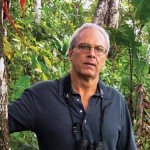
A member of the Stenocara genus. Image: Wikimedia Commons
Inspired by the biological structure of the desert-dwelling Stenocara beetle, University of Sydney researcher Dr Chiara Neto’s groundbreaking water collection technology could soon bring relief to drought-stricken areas.
A research paper published by a zoologist back in 2001 became the unlikely catalyst for Dr Neto’s decade-long research project on water collection techniques. “The idea explained in the paper was that the Stenocara beetle used a particular kind of chemistry to collect water. It lives in a very arid area. In order to survive [it] collects water by placing its back towards the fog at dawn,” explains Neto.
The beetle, the study confirmed, can survive by a unique process of condensation, aided by small, water-loving (hydrophilic) bumps spread on a water-repellent (hydrophobic) shell. Water droplets forming on the shell could slowly grow in size and would later be drawn into the bumps to provide the creature with hydration.
Neto and her team have successfully devised a way of synthesising polymeric material to replicate this water-gathering method in a way that could be used cost-effectively, on a large scale. This material, applied as a surface coating, is able to capture moisture from the air for storage and re-use. “It’s in its early stages, but we’ve already collected promising results,” she says.
This technology could have exciting applications both here and abroad. “In Australia, we have this particular condition where most of the population lives near the coast. Quite a lot of water can be used from the atmosphere. It could [also] be a very cheap way to collect water in developing countries,” Neto adds.
“We’re still at the stage of optimising the material and the size of the bumps, but in a few years we might be able to have a pilot structure that could be constructed on the side of a house.”
After studying chemistry in Florence, Italy, Neto made a strategic move to Australia to complete her doctorate. “That’s where I became interested in how liquids interact with solids,” she explains. “When I started my PhD I really wanted to investigate a particular topic [in this area], which had little expertise in Florence. The pioneers of this technique were in Australia.”






